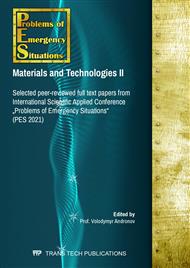p.3
p.9
p.15
p.25
p.33
p.40
p.51
p.61
Repeatability of Sheet Material Formation Results and Interchangeability of Processing Modes at Multi-Pass Laser Formation
Abstract:
Laser shaping of sheet materials is a flexible process and is carried out without force contact on the material, it allows forming, among other things, brittle, elastic and difficult-to-deformed materials. It is known that the main parameters of laser shaping are the beam power, the size of the focus zone and the speed of beam movement along the surface of the workpiece, however, the range of variation of these parameters is not unlimited, but due to the characteristics of a particular equipment. Therefore, it is necessary to develop an approach to selecting processing modes that can be selected from the range available on the equipment and at the same time obtain a predictable result. There is also a need to investigate a reproducibility of laser shaping results with a lot of pass-through processing. Actually, this study is aimed at solving these issues. In particular, the article formulates a provision on complex formation parameters that allow determining interchangeable modes of laser molding processing and varying parameters in ranges available on equipment. For this, the basic processing mode was chosen, formation was carried out with a fixed number of passes, after which, using complex parameters, alternative modes were determined and formation was carried out under these conditions with the same number of passes. The article also presents the methodology and results of experimental studies of checking the interchangeability of formation modes and the repeatability of formation results during processing along parallel and multi-directional trajectories. It was experimentally found that the deviation of the strain value obtained in alternative modes, compared to the base, and did not exceed 2.46% for a three-pass cycle and 5.8% - for a nine-pass cycle. And the repeatability of the formation results during laser shaping is quite high; the discrepancy in the deformation value did not exceed 5%, and, preferably, was lower.
Info:
Periodical:
Pages:
15-24
Citation:
Online since:
July 2021
Keywords:
Price:
Сopyright:
© 2021 Trans Tech Publications Ltd. All Rights Reserved
Share:
Citation:


